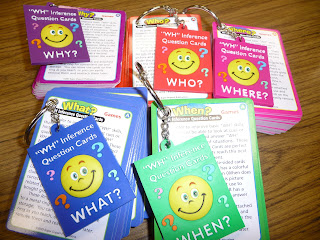WH questions seem to be the single hardest skill for many of the students
on my caseload. Not only is it hard to
start with – there are so many levels that you need to help your students
build. Answering questions is difficult for both children with language disability and children who are English langauge learners. It really impacts student's ability to communicate with their friends, family and teachers. An inability to answer WH questions also impacts development of reading comprehension and performance in the classroom.
Now that we've had a quick reminder that questions are *important* - what next?
Starting with yes and no questions and simple what questions, most students need to be taught to answer each question type individually. What demands a thing, who a person, where a
place, when a time and why a reason. For
this simple level I like to use the WH Inference Cards by
Super Duper Publications. Super Duper has other WH cards that I don't like for a variety of reasons.
The basic WH question cards require a simple answer from a student, but
to get the answer right they need to know that bees make honey, spiders
make webs and cows give us milk. I work with students from multiple
linguistic backgrounds and from a low socioeconomic status. Sometimes
these little bits of knowledge are really too much to ask. My other
main complaint about traditional WH question cards is that during
therapy some students memorize the answers to the cards presented, and
need to be retaught how to answer the questions in different contexts.
 |
| WH Inference Cards |
When working on questions - it is always useful to have a Questions Chart (linked to google docs) to help us figure out how to answer questions. Many of my kids are visual learners or learn best when a skill is addressed through multiple modalities. I have also delivered this into the hands of teachers working on classroom interventions.
I use the inference question cards to start working on questions, and from there, a variety of materials exist to help practice. I am a big advocate of using as many things as possible in therapy to promote generalization of their skills. I can't count how many things I've found even in a quick search online, but below are some of my favorite ones to use.
WH Chipper Chat by Super Duper
10 boards, each with a list provided list of questions. Some of the questions directly relate to the picture on the board, others are more personal to each student, such as "Do you like..." When working in groups this is a great activity to start to build question asking skills rather than just working on answering questions. After you ask a student a question, tell them to "Find out if ____ likes puzzles too." or to "Ask ___, do you like puzzles?" This helps to remind students to pay attention on everyone's turn and to help build connetions between asking questions and answering questions.
Ivan's Iceberg by Linguisystems
This game comes with yes/no, what, who, where, why, how and when question cards. Each card has a picture and 3 questions. The students take turns at the game and practice answering questions. The variety of practice materials that come with this game have made it easy to seamlessly switch back and forth between students working at different skill levels and on different question types.
What's Happening Photo Cards by Lakeshore Learning
I love using any pictures in therapy, not just limited to answering questions, but these are particularly targeted toward answering questions. The back of every card has questions at multiple levels, the kids can grab and read the back of the cards to their heart's content, but still have to use their brains to come up with the answers.
One question type that is always particularly sticky to get kids to answer is Why questions. There are several ways to answer the different questions that kids seem to get a little stuck. For one student in particular, I ended up writing out the answers to most of the "Why Inference" cards pictured above in all three ways, showing because, so and to. We practiced sorting the different answers into the correct format, and then practiced generating the answers. We used a Color Coded Chart (why questions) (linked to google docs) and color coded markers to represent the different parts of the question. With targeted strategies used by me, a home intervener and some homework, this student went from responding to ALL questions with "yes" to being able to respond to Why questions in her school work appropriately.
Working on question skills is a never ending activity... More ideas later!




Great Ideas and I have wanted those WH inference cards for a while, but it seemed to not make my orders because my kids working on this could not answer basic ones. I like your reasoning. I have made a variety of interactive, talking card sets on quizlet for answering questions: https://quizlet.com/coyleSLP/folders/answering-questions/sets and asking questions: https://quizlet.com/coyleSLP/folders/asking-questions/sets. I use a chart similar to yours but with my own picture cues that I drew. Michelle Coyle Ms CCC/SLP
ReplyDelete